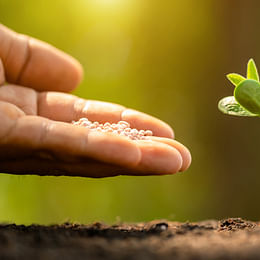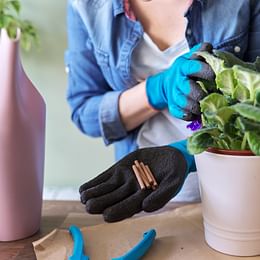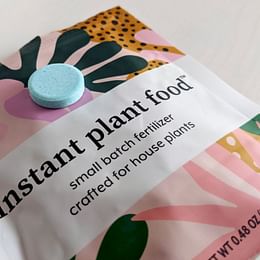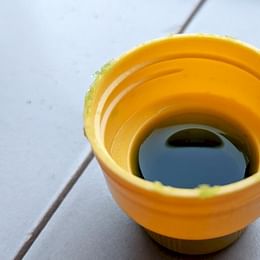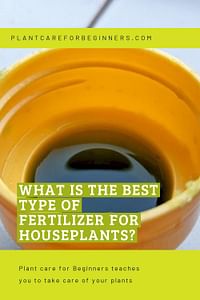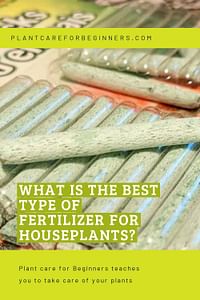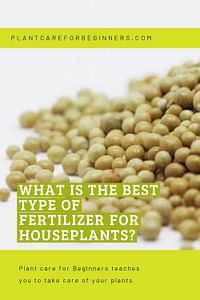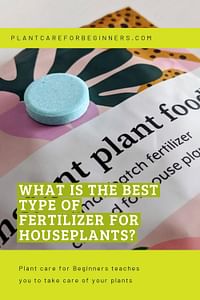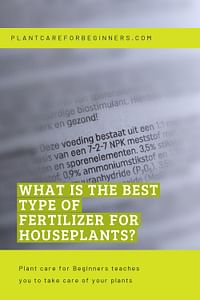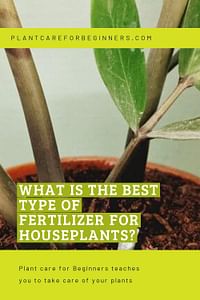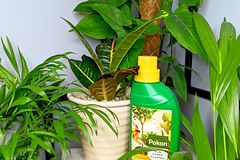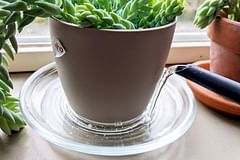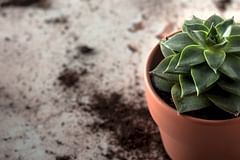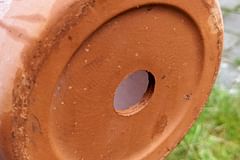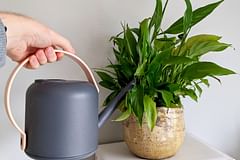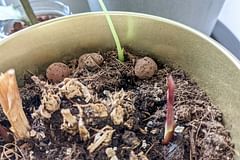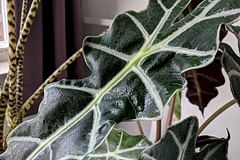What is the best type of fertilizer for houseplants?
Fertilizing your plants is a great way to help your plants grow bigger, strong, and faster. In this guide, we're going to look at different types of fertilizer and we're going to find out which type is the best for your plant care style.
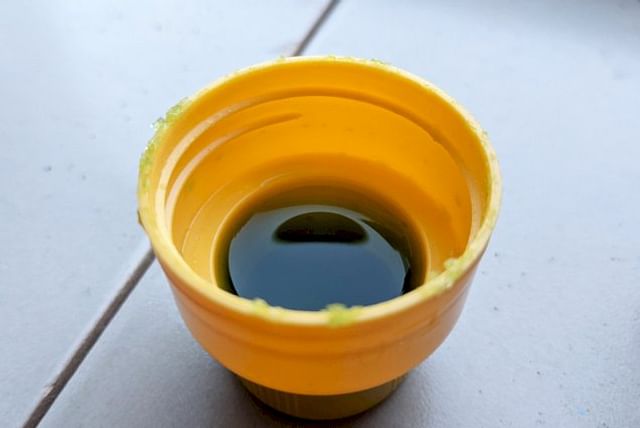
Fertilizing your plants is a great way to help your plants grow bigger, strong, and faster. The nutrients it gives your plants are also essential to keep it healthy in the long run and help it recover from damage and pests. Often, the soil that came with your plant already contains fertilizer, so your plant will grow more quickly in the beginning and then slow down their growth after some months. Your plant will have used up all the nutrients the soil came with and it will need more of them to continue growing like it did.
But what is the best way to fertilize your plant and do all plants need the same level of fertilization? These are some great questions we're going to look at in this plant care guide. We'll cover these topics:
- Do all plants need fertilizer?
- When is the best time to fertilize your houseplants?
- The different types of fertilizer for houseplants
- Organic vs. synthetic fertilizers
- How can I read the fertilizer label to understand what I need for my plants?
- How to choose the right fertilizer for specific types of houseplants?
- The best fertilizer to use for houseplants
- Should I water my plants before or after fertilizing?
- How can I make my own homemade fertilizer for houseplants?
- Conclusion
First, we're going to clarify some confusion about fertilizer. It's important to know what it is and what it is not. Then we'll get into the information you came here for.
Do all plants need fertilizer?
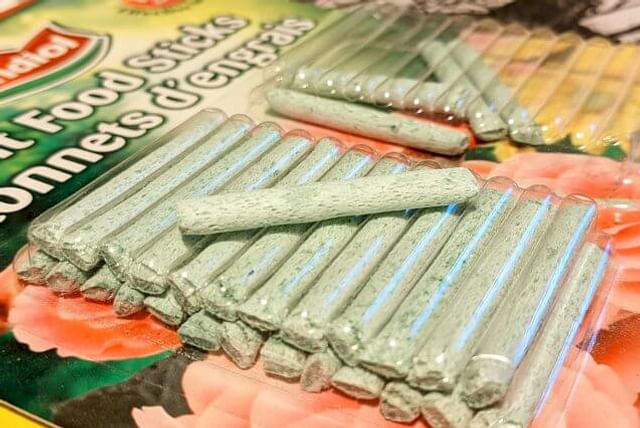
All plants need nutrients to grow, so all plants will need fertilizer at some point. However, plants don't all need the same amount of fertilizer to grow well. For example, if you have a very slow-growing plant like a succulent, you won't need to fertilize as much as you would for a fast-growing plant like an Alocasia. Alocasias are fast-growing plants, which means they need a lot of nutrients to grow big and strong.
All plants need fertilizer at some point, and forgetting to fertilize means your plant won't grow as quickly or will stop growing altogether. But, you can also fertilize plants too much. This could happen when you fertilize your plant before it could absorb all the nutrients in the soil from the last time your fertilized. Too much fertilizer turns the soil acidic over time, which makes it a tough place to survive for your houseplant.
In the next section, we'll discover when you should fertilize your houseplants and when it's better not to do it.
When is the best time to fertilize your houseplants?
We've discovered that some plants need less fertilizer than others, but what does that really mean? Does it mean that you give them less concentrated fertilizer? That could be an option, but that's difficult to keep track of. A better way is to increase the amount of time between fertilizing.
Slow-growing plants
The best time to fertilize plants that don't need a lot of nutrients, like the slow-growing succulents, is once at the beginning of spring and once at the beginning of summer. However, there is one thing to think about when you're considering fertilizing your slow-growing plants.
Since these plants don't use a lot of nutrients throughout the year it's a good idea to wait at least 3 months before fertilizing your plants if you've bought it from the store or if you've changed their soil. Often, fresh soil contains nutrients for the first 100 days, after which you'll need to add fertilizer yourself. If you add fertilizer before the 100 days are up, you could risk over fertilizing your plant.
Fast-growing plants
Fast-growing plants like (but not limited to) Monsteras, Alocasias, and Spider plants need a lot more nutrients throughout the year than slower growing plants. The ideal time to fertilize these fast-growing plants is once per month in the spring and summer. This is their growing season in which they grow many leaves at the same time.
During the autumn/fall and winter, they go into their dormancy period during which they grow very slowly or not at all. During this time, you should not fertilize your fast-growing plants, as they won't absorb much of the nutrients and this could turn the soil acidic.
The different types of fertilizer for houseplants
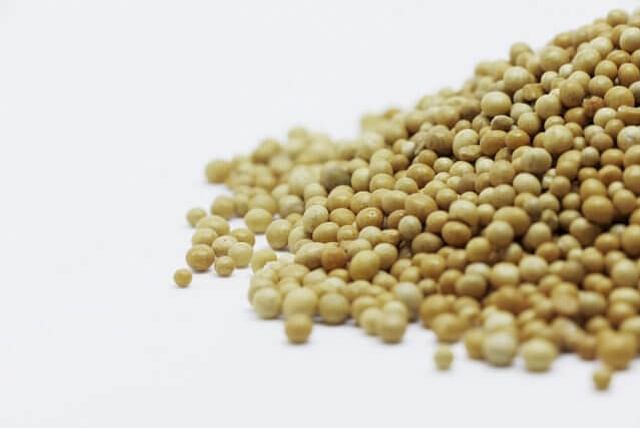
When it comes to the different types of fertilizer for houseplants, there are a few options. You can choose the fertilizer that fits your plant care style best. Among several more advanced ways to fertilize your plants, like adding used ground coffee and eggshells, there are also a few easier ways to fertilize your plants that can fit your plant care style well:
- Liquid fertilizer
- Fertilizing spikes
- Fertilizing balls
- Fertilizing tablets
We'll briefly go over each and see if they're a good fit for you or not.
Liquid fertilizer
Liquid fertilizer is a fertilizer that you add to your water. When you water your plants, you're also adding fertilizer to the soil. This is an easy way to fertilize your plants, as you don't have to do anything extra besides watering your plants. However, there are two downsides: you actively need to remember to add fertilizer to you water and dosage is everything.
It's easy to add too much fertilizer to your water and this could make it difficult for your plant to stay healthy. When in doubt, always read the instructions that came with your fertilizer.
What is the best method to apply liquid fertilizer?
For liquid fertilizers, you should mix them with water as per the instructions on the label. Water your plant with this mixture to make sure the nutrients can spread throughout the soil and reach the roots effectively. Just be careful not to pour it directly onto the leaves; their surface can get burned by the fertilizer if it's too concentrated.
Fertilizing spikes
Fertilizing spikes are small sticks that you stick in the soil. Most of these spikes will fertilize your plant for up to 100 days. They will absorb water when you water your plant and release nutrients into the soil. The spikes, along with the Fertilizing balls, are also called slow-release fertilizers. This way of fertilizing your plants is a do it once and forget about it for about 3 months.
Forgetting about it is also one of it's downsides though. If you forget that you put one of these spikes in your soil a few weeks ago and add another stick, you might give your plant too many nutrients that it won't be able to absorb. If you're using these spikes, it's a good idea to add reminders on your calendar to add spikes to the soil and stick to your schedule. This way you're more likely to give your plant the right amount of nutrients.
Fertilizing balls
Fertilizing balls are much like the fertilizing spikes in the sense that they're a use it once and forget about it for a while. They're also a slow-release fertilizer, which comes with the same benefits and disadvantages as the spikes. However, there is more.
These fertilizing balls are very small and are supposed to be mixed in with your soil. This has the benefit that it feeds your plant throughout the whole pot, not just from a single spot. However, this also means it's a little more involved when the nutrients run out.
You either have to dig holes in your pot of you have to refresh your soil.
So in summary, it feeds your plant more consistently, but it also takes more work.
How deep should I place fertilizing spikes or balls when using them?
If you're using fertilizing spikes, placement is important! You want to insert them into the soil about 2.5 to 8 cm (1-3 inches) down. If they're too shallow, and they might dry out too quickly; too deep, and the roots might not access them. A general rule of thumb is to place a spike for every 15 to 20 cm (6 to 8 inches) of pot diameter. So for smaller pots, that would mean you'd only add one spike to the pot.
If you're using fertilizer balls, it's easiest to mix them through your soil. So ideally, you add them to your pot while repotting your plant. If that's not an option, you can also place them slightly below the surface of the soil. When you water your plant, the nutrients will slowly flow down towards the roots.
Water thoroughly after adding these fertilizers to the pot to help the nutrients dissolve and spread into the root zone.
Fertilizing tablets
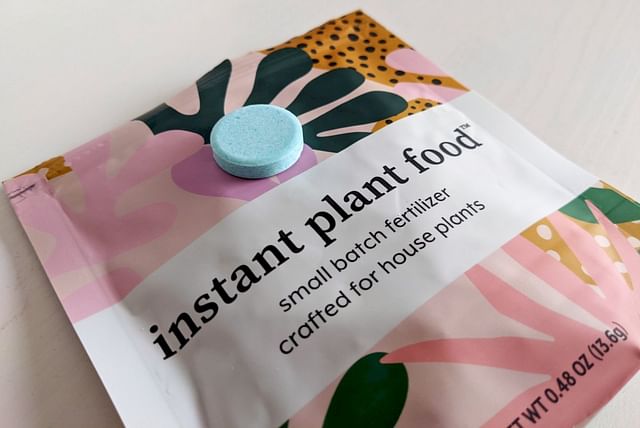
Fertilizer tablets are a great compromise between liquid fertilizer and fertilizer balls/spikes. These tablets are dissolved in water, which makes them very easy to absorb for your plants. However, they also last much longer than most liquid fertilizers, which makes them like the spikes and balls. The tablets are concentrated, which means they pack a punch.
One of my favorite tablets is "instant plant food". They're concentrated tablets, that can feed a big plant or a few smaller plants for several months. Since you dissolve these tablets in water, your plant can absorb the nutrients quickly, so it can help your plants quickly.
Organic vs. synthetic fertilizers
As plant parents, we want to give our plants the best (within reason). So if you've looked at getting fertilizer before, you might have come across a few different organic and synthetic fertilizers. If you're like me, you might like the sound of an organic fertilizer and a synthetic fertilizer sounds like it's bad for your plants.
But, that's a misconception, sort of.
Both organic and synthetic fertilizers have their pro's and cons.
Where synthetic fertilizers shine
Synthetic fertilizers, also known as chemical fertilizers, are man-made products designed to provide specific nutrients to plants quickly and efficiently. They usually contain three primary nutrients: nitrogen (N), phosphorus (P), and potassium (K), which you might recognized as the N-P-K ratio on the packaging. Each nutrient is important for keeping your plant healthy.
Nitrogen promotes leafy growth, phosphorus is good for root and flower development, and potassium is for general plant health and disease resistance.
Synthetic fertilizers are man-made, so their very efficient in feeding your plants quickly. They're great for helping you solve nutrient deficiencies or helping your plant grow more quickly.
Synthetic fertilizers are easy to use, have very precise instructions, and take very little effort to use. So they're perfect for busy people, beginning plant owners, or people that just have a lot of houseplants to take care of.
But, synthetic fertilizers do have some downsides, like all things in life. Over time, the use of chemical fertilizers can lead to nutrient leaching, poorer soil quality, and a decline in soil health, which can make plants more vulnerable to pests and diseases. High concentrations of synthetic fertilizers can cause root/nutrient burn, which can damage your plant.
I do have some good new for you though: If you stick to your regular repotting schedule (repot once ever 2/3 years), your plant should be fine if you follow the fertilizing instructions on the label.
Why organic fertilizer is great too
Let's look at organic fertilizers, shall we?
Organic fertilizers are made from organic, natural ingredients. These ingredients can be many things, but the most common are compost, manure, and plant extracts.
If you're not sure what to picture when you think about organic fertilizer, let's look at an example. In the fall, trees drop their leaves. These leaves fall on the ground and slowly degrade over time. This gives the soil underneath a nutrient boost that the tree uses to keep growing in the spring. The same goes for houseplants and organic fertilizer.
The example also highlights another benefit of organic fertilizer and that is that it's a slow-release fertilizer. It takes a little longer for this type of fertilizer to be release to your plant. This leads to a more consistent food supply, which also help to prevent over fertilizing your houseplants.
Where synthetic fertilizer can lead to poor soil health over time, organic fertilizer actually improve the soil quality. The slow release of natural nutrients make the soil very fertile and boosts microbial activity. This helps your plants become stronger and resilient to pests and diseases.
Organic fertilizers are also safe for all types of houseplants, as they're much easier on the plant's roots.
So what are the downsides?
Organic fertilizers take a lot longer to feed your plant. It's not a quick fix if you notice something is wrong with your plant. It takes more work to prepare, is much less consistent in nutrients, can't be preserved for very long and can spread diseases, pests, and weeds from the source to your houseplant.
If you're planning on using organic fertilizers, you can't really do so without a plan. It simply takes more work. But it's also much less harmful to your plants in the long run.
So what should you choose? I recommend a balance. Organic fertilizer is great for long term use, but sometimes your plant just needs a boost from the synthetic fertilizer.
How can I read the fertilizer label to understand what I need for my plants?
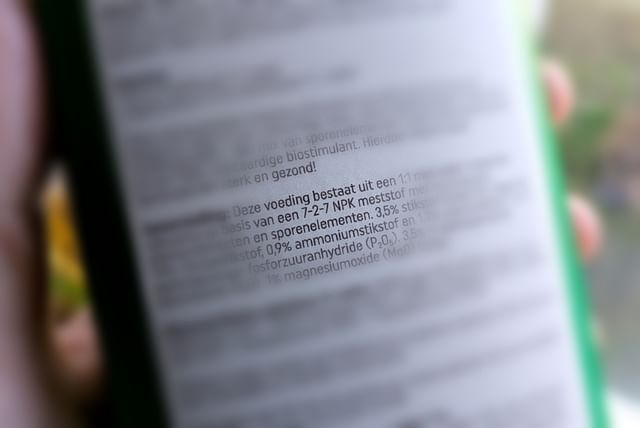
Navigating the world of plant care can feel like a jungle of information, but understanding fertilizer labels is one of the first steps toward becoming a confident plant parent. Those little numbers and letters might seem like a mysterious code at first, but they hold the key to nurturing your greenery just right. Once you get the hang of it, it's pretty straightforward!
Look for the N-P-K ratio, which stands for nitrogen (N), phosphorus (P), and potassium (K). This represents the primary nutrients your plants need. For example, a fertilizer with a ratio of 10-10-10 is well-balanced, making it ideal for plants that need all-around nourishment.
If you’re unsure, many garden centers have staff who can help you pick the right one. Remember, the best fertilizer is one tailored to what your plants crave!
How to choose the right fertilizer for specific types of houseplants?
Choosing the right fertilizer for your houseplants can feel overwhelming, especially with so many options out there. Let's dive into fertilizer recommendations for some popular houseplants, so you have a better idea what to look for when your shopping for fertilizer.
| Plant Type | Ideal NPK Range | Fertilizer Frequency |
|---|---|---|
| Succulents | 2-4-8 or 1-2-2 | Every 4-6 weeks during growing season, reduce in winter |
| Cacti | 5-10-10 | Every 4-6 weeks during growing season, halt in winter |
| Tropical Plants (e.g., pothos, peace lilies) | 10-10-10 or 20-20-20 | Every 4-6 weeks during spring and summer, cut back in late fall and winter |
| Ferns | 10-3-10 (diluted) | Every 4-6 weeks when actively growing, lessen during dormancy |
| Orchids | 30-10-10 or 20-20-20 | Every 2-4 weeks during growing season, dilute to half strength |
| Flowering Plants (e.g., African violets, geraniums) | 15-30-15 or 10-20-20 | Every 4-6 weeks during flowering period, reduce in off-season |
The best fertilizer to use for houseplants
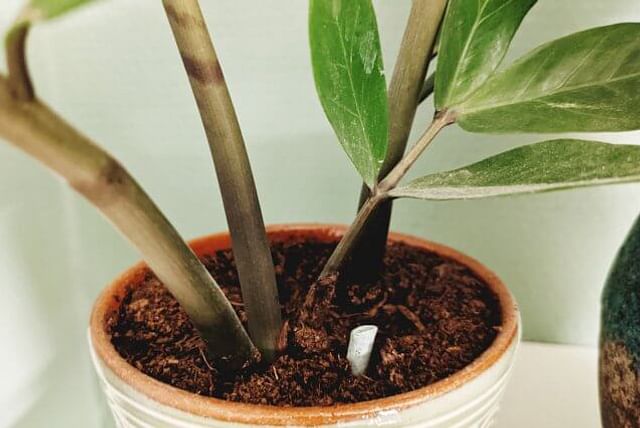
We've seen 4 different beginner-friendly types of fertilizer for houseplants, but which one is the best one of them all? The answer is, they're all great ways of fertilizing your houseplant. The one that's easiest for you to do is the best one to do.
So let's describe the type of plant owner you need to be for these three fertilizers to find out which one is perfect for you.
Liquid fertilizer is perfect for you if you always remember to take care of your plants in a timely manner, while being taking great pride into finding the perfect combination of things to help your plant thrive.
You love experimenting with different types of plants and if you could you'd want to take care of your plant every day.
Your favorite plants are tropical plants.
Fertilizing spikes are perfect for you if you always forget about your plants for at least 2 weeks at a time.
You buy low-maintenance plants or have found ways to make higher maintenance plants a little less effort.
You pay attention to when your plant starts to grow more slowly during the growing season.
Fertilizing balls are perfect for you if you like to make sure your plant is always comfortable in its pot and you don't mind repotting your plant once per year to make this happen.
You don't have time to take care of your plants every day, but you do like to spend a little longer on them once per week or once every two weeks.
Fertilizing tablets are perfect for you if you have many larger plants and you forget to fertilize your plants sometimes.
The fertilizing tablets help your plants grow long-term, while also making it very easy for your plants to absorb the nutrients to grow more quickly.
Should I water my plants before or after fertilizing?
Watering your plant when fertilizing is very important, because it helps your plant to absorb the nutrients, it spreads the nutrients throughout the pot, and it helps to prevent nutrient/root burn.
So should you water your plant before or after fertilizing?
It depends on the type of fertilizer you're using. If you're applying liquid fertilizer, it's a good idea to water your plants before fertilizing. This pre-watering helps the roots to absorb the nutrients effectively and reduces the risk of fertilizer burn. If your plant's soil is too dry, the fertilizer can become highly concentrated around the roots, which leads to damage and nutrient problems.
However when you're using slow-release granules or spikes, you can apply the fertilizer first and then follow up with watering afterwards. This way, watering helps to spread the fertilizer throughout the soil and starts to gradually release of nutrients over time, so your plants get a steady supply of food as they need it.
How can I make my own homemade fertilizer for houseplants?
Creating your own homemade fertilizer for houseplants is not only a sustainable choice but also a fun way to give your plants a nutrient boost using materials you already have at home. Homemade fertilizers can provide essential nutrients while minimizing waste and reducing your dependence on store-bought products. Let's explore some easy methods to create up your own organic plant food!
Making homemade fertilizer can be as simple as mixing a few natural ingredients commonly found in your kitchen. One popular method is to create a compost tea: steep a handful of compost in a bucket of water for about 24-48 hours, then strain the liquid and dilute it with more water (about one part compost tea to three parts water). This nutrient-rich solution can be poured directly onto your plants to give them a nice dose of nutrients.
For a few more fun ideas on creating your own plant fertilizer, have a look at DIY Plant Fertilizer for Indoor Plants: 5 Recipes to Try.
Conclusion
Fertilizing your plants is very important to keep your plants strong and healthy over a longer period of time. Fertilizing your plants is often one of those things you overlook, because watering and sunlight are the most important things to keep in mind when you take care of your plant. However, without nutrients, your plant won't be able to grow bigger or recover from damages or pests as easily. Any living organism, including humans and plants need nutrients to survive and (hopefully) thrive.
Thank you for reading this post! I hope it helps you to keep your plants healthy and beautiful! If you're looking for more guides on specific plants, you can always request a plant guide to get a guide for the plant you have trouble with.
Test your plant care knowledge
Quiz completed!
Want to learn more? Sign up for my newsletter to receive free tips in your inbox!
Sign up now!